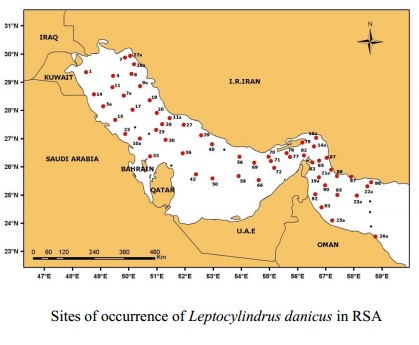Leptocylindrus danicus Cleve
 Division: Chromophyta
Division: Chromophyta
Class: Bacillariophyceae
Order: Biddulphiales
Suborder: Coscinodiscineae
Family: Leptocylindraceae Lebour
Genus: Leptocylindrus Cleve
Scientific name: Leptocylindrus danicus Cleve

Cells long, cylindrical, united into chains by whole valve surface. Valves flat, without spines or processes. Intercalary bands present, but very difficult to see. Cells thin-walled, hyaline,without visible sculpturing. Chromatophores one or many roundish plates or granules.Resting spores known (Cupp, 1943).
In Winter 2006 Cruise, the genus Leptocylindrus included three species, of which Leptocylindrus danicus was the most bundant. The genus contains small-sized chainforming diatom algae. When abundant, it contributed up to 50 % of the total hytoplankton abundance; the highest concentration reached up to 9.2*10^4 cells/l. High abundance ofLeptocylindrus spp. (>104cells/l) was recorded in the northwestern part of the inner RSA, inthe southern part of the inner RSA near the Strait of Hormuz (off the Iranian coast) and in the Sea of Oman.
Scientific name: Leptocylindrus danicus Cleve
References:
Pavillard, 1925: p. 24, Fig. 35; Hustedt, 1930: p. 559, Fig. 318, 319; Allen and Cupp, 1935: p. 124, Fig. 27; Cupp, 1943: p. 77, Fig. 39; Crosby and Wood, 1958: p. 524, Pl. 39: 80; Hendey, 1964: p. 140, Pl. V: 2; Ricard,1987: p. 175, Fig. 250; Throndsen et al., 2007: p. 146.
Description:
Cells cylindrical, 7-10 µm in diameter, two to ten times as long. United in closed, long, stiff chains. Valves flat or convex, occasionally concave,without visible sculpturing. Adjacent cells often with only one cell wall between two valves. Intercalary bands present, but very difficult to see. Chromatophores, few to numerous, not very small, oval plates, distributed throughout the cell. Resting spores and auxospores known.Resting spores covered with spicules (Cupp, 1943).
Dimensions:
Cells length 32-37 µm; diameter 9-10 µm.
Distribution:
Neritic species, widespread distribution.
Sites of occurrence in RSA:
In Winter 2006 Cruise, this species was commonly observed at various sites (refer sites map),often in large numbers; maximum abundance (9.2*10^4cells/l) was associated with the north-western part of the inner RSA (St. 9a). Species has been previously reported from Kuwaiti waters of the inner RSA (Al-Yamani et al., 2004; Al-Kandari et al., 2009).

Harmful Effect:
Nontoxic bloom-forming species. Blooms of this species may produce fish kill in mariculture cages (Yan et al., 2008 – www.pices.int/publications/scientific_reports/Report23/HAB_China.pdf).


